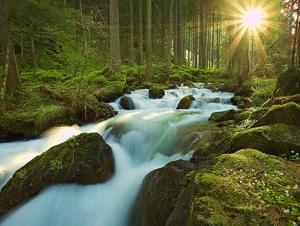Nature in psychotherapy
(Image by Flickr user rachel_thecat (cc: by-nc-sa))
This story is adapted from a broadcast audio segment; use audio player to listen to story in its entirety.
Xanax, Zoloft, Prozac, Valium. These drugs fill many a medicine cabinet, helping people relax and cope with depression and anxiety. But what if a simple walk in the woods could dissolve that black cloud that lingers over your head instead?
That’s part of the treatment psychotherapist Linda Buzzell offers her clients. She says the emerging practice called ecotherapy blends nature with traditional psychotherapy.
“It really is sort of green psychotherapy or psychotherapy as if the whole planet mattered,” she said. “This really evolved from ecopsychology, which is the study of the human-nature relationship. And ecopsychology became popular in the early 1990s.”
While this may sound like a lot of New Age thinking, Buzzell says it’s grounded in scientific study.
“Keep in mind the fact that the University of Essex in the UK just did a really important study, and they found that connecting with nature, a simple walk in nature, was as powerful as antidepressant medication in cases of mild to moderate depression,” she said. “That may not sound really earth shattering, but it really is for the field of psychotherapy, because so much medication is now being used now for mild and moderate depression. And what if we could get the results that we want without any of the side effects or the expense of the medication, simply by helping people reconnect with nature in their areas.”
Buzzell, a psychotherapist for over 25 years, experienced nature’s healing effects when she began gardening. This led her to delve deeper into ecotherapy.
“I became amazed as I was doing this when I began to realize that it wasn’t just me working the garden; that the garden was somehow changing me,” she said. “And it was having these wonderful affects on my mood and my levels of anxiety, and I thought wow, this is really a very healing thing. I gotta find out more about it.”
She says an ecotherapist looks at psychotherapy through a lens that connects people with nature. They may ask about a person’s relationship with nature, whether they’re connected with a special place or an animal, and what kind of meaning these things evoke in them. The other difference is where the therapy takes place: Outdoors, in a garden or other natural setting, instead of in an office.
“One thing that I sometimes ask people to do is fill out a time diary,” she said. “And a time diary helps them see how much time they spend inside versus outside. How much time they spend looking at a screen, whether it’s a computer or a Blackberry or whatever it is, or a television, versus how much time they spend looking into the faces of other people or into nature.
“And it’s often really amazing to see the results, and people realize that we’re living very, very unnaturally, and that it actually may be true that the way that we live may be causing these epidemics of depression and anxiety that go on in Western civilization. So, one of the easy things that we can do is begin to shift the lifestyle just slightly, have a little more nature, a little more calm; get off some of the media, actually allow people to take a media fast for a couple of days and see if that helps at all in terms of helping the depression or lowering the anxiety levels.”
Hosted by Steve Curwood, “Living on Earth” is an award-winning environmental news program that delves into the leading issues affecting the world we inhabit. More “Living on Earth.”
